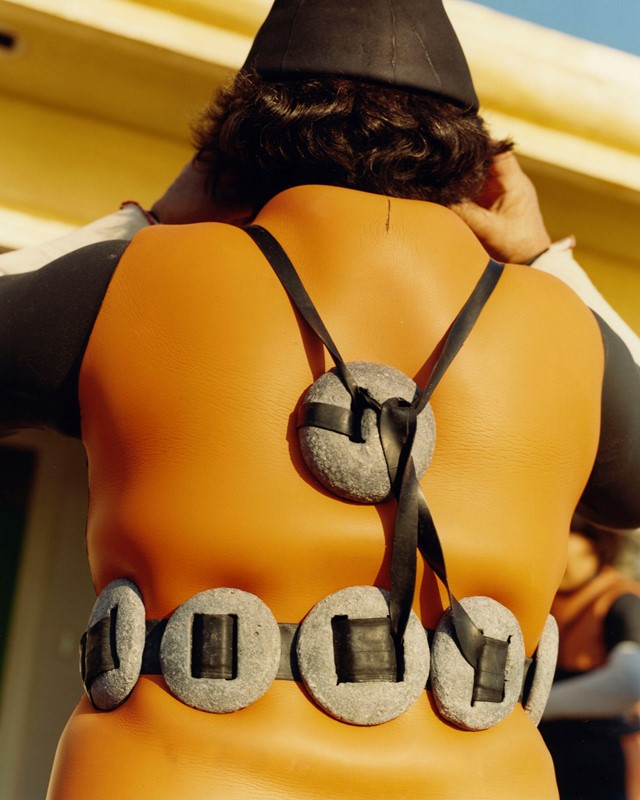In his debut book The Last Mermaid, New York-based fashion photographer Peter Ash Lee turns his lens on a waning community of female divers called the Haenyo
In December 2018, Peter Ash Lee travelled to Jeju Island – a tropical province nicknamed the ‘Hawaii of Korea’ – to photograph a community of women divers, called the Haenyo, that have, for centuries, been the main breadwinners for their families. Most of the women, who are between 60 and 80 years old, spend hours in the open sea scouring for sea urchin, turban conch, sea cucumbers and octopi without any modern diving equipment. Ko Ryou Jin is the youngest, in her mid-30s, and comes from three generations of Haenyo. She continues to dive with her mother, who has been working for more than 40 years, but knows that due to the job’s difficulty, she might just be the “last mermaid”.
Lee spent three days on the island, meeting the divers at 6am as they were readying themselves for sea, and on their return where they would weigh their catch. The results have now been compiled in The Last Mermaid, a self-published photo book. As a fashion photographer, Lee was drawn to small details: a pair of rubber slippers with a hand-drawn Nike swoosh and a Comme des Garçons logo, and a woman holding an octopus in each hand, a Chanel scarf wrapped around her head. “Some of the women’s poses just felt like a fashion image,” he says. “It just had such strength.”
Here, in his own words, Peter Ash Lee shares the story behind his book.
“The Haenyo are such amazing women, full of energy and they’re in their 70s and 80s. They’re diving for eight hours, lugging a net of a hundred pounds of seafood they’ve caught out of the ocean. A lot of them had these lead stones that were attached to their back to help them dive. The youngest Haenyo tried to explain to her mother and the other ladies that the lead is quite poisonous, and she’s switched to more modern weights and wetsuits, but they were all like, ‘We’ve been doing this for years, we’re not going to change now.’
“They free dive and don’t even use snorkels. I was asking them: ‘Wouldn’t that make it easier to kind of scour the seafloor to see what you’re looking for?’ And one of the ladies told me: ‘Well, that would be cheating.’

“For hundreds of years, they’ve maintained this sustainable practice, but because of global warming – they say there’s been a two degree celsius change in the water – everything has been thrown off balance. Now, they have to swim at least an hour in the morning before they find anything to catch. It’s creating an overabundance of sea urchins at the wrong times, which is destroying the foods that the conch needs to survive. It’s also gotten a lot more dangerous for the Haenyo, because there are venomous sea snakes and octopi coming over from Thailand, where the waters are warmer.
“The youngest has been actively trying to recruit more Haenyo. She’s been on national television shows and leads these Haenyo experience trips where people try diving for a day. But she says the nature of the job is very difficult and laborious. We were conversing the whole time in Korean but then she said: ‘I’m basically the last mermaid’ in English. It left such an impact on me.
“She had gone through a divorce and had a young daughter, and diving became this path to healing. I don’t think she had ever planned to follow in her mother and grandmother’s footsteps but it became the thing that saved her. At first, she was just trying to not drown and spend hours out there, but you have to be good at actually catching to make a living.

“Korea has traditionally been, and still is, quite a patriarchal society. But on Jeju Island, for generations, it has been a semi-matriarchal society. The Jeju women are notorious for being the strongest and Ko Ryou Jin would make these jokes like, ‘You know, the Seoul men can’t handle us because we’re too strong.’
“This was my first project outside of commercial and fashion photography. It was important for me to tell my own story, go back into my culture and find something that’s unique to Korea. I hadn’t seen previous books that were made of the Haenyo by Korean photographers. But for me, it felt very personal. I was really close to my grandmother who passed away a couple of years ago, and so going out there and spending time with them, it almost felt familial, like hanging out with my grandmothers and aunts, and I think that was quite special.”
The Last Mermaid by Peter Ash Lee will be published in November. Photos from the series will go on show at Where Land Meets Sea, a group exhibition at Stroll Garden in East Hampton, New York from 12 August - 4 September 2023.






